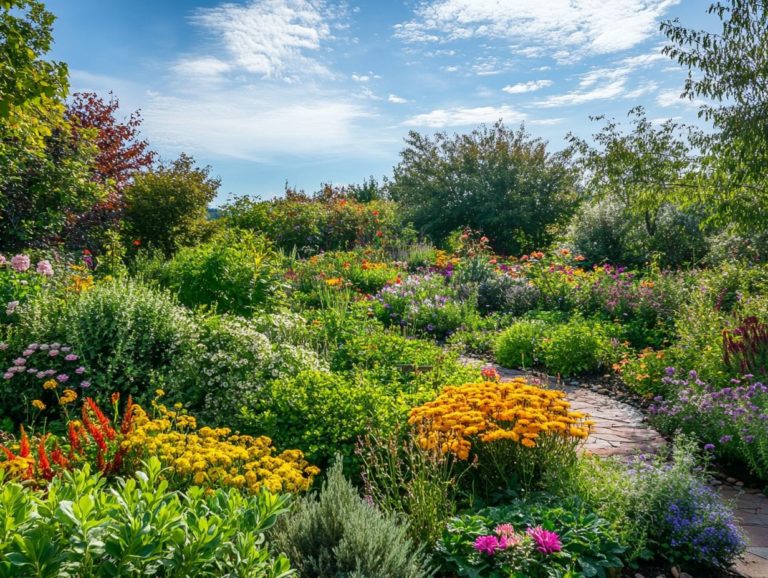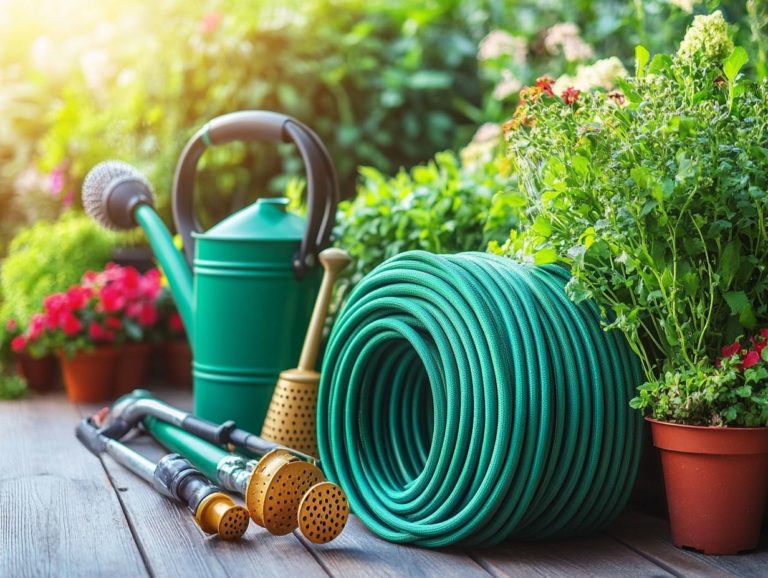Tips for Managing Water Runoff in Gardens
Water runoff can pose significant challenges for any gardener, resulting in soil erosion, nutrient depletion, and a range of environmental issues, particularly in home gardening and urban landscaping.
Grasping the causes behind this phenomenon is essential for anyone dedicated to cultivating a flourishing ecosystem and understanding the environmental impact of their gardening practices.
This exploration delves into the detrimental effects of stormwater runoff on gardens and the broader environment, while also offering effective strategies for its management and pollution filtration.
From selecting the most suitable plants to implementing efficient drainage systems, you ll uncover practical tips designed to help your garden thrive in the face of excess water challenges.
Contents
- Key Takeaways:
- Unlock the Secrets of Water Runoff Management in Your Garden!
- The Negative Effects of Water Runoff
- Strategies for Managing Water Runoff
- Choosing the Right Plants for Water Management
- Implementing Drainage Systems
- Frequently Asked Questions
- What is water runoff and why is it a concern for gardeners?
- What are some tips for managing water runoff in gardens?
- How can I prevent erosion caused by water runoff in my garden?
- Can water runoff be controlled in a sloped garden?
- What are the benefits of managing water runoff in gardens?
- Are there any alternatives to traditional methods for managing water runoff in gardens?
Key Takeaways:

- Understand what causes stormwater runoff in gardens to effectively manage it.
- Be aware of the negative impacts of stormwater pollution on the environment and your garden.
- Employ prevention and mitigation techniques, such as rain gardens and mulching, to manage water runoff in gardens.
- Select appropriate native plants to help absorb excess water in gardens.
- Implement proper drainage systems to effectively manage water conservation and reduce runoff in gardens.
Unlock the Secrets of Water Runoff Management in Your Garden!
Understanding water runoff in your garden is crucial for effective water management and sustainable gardening practices, particularly in urban settings where stormwater runoff can result in flooding and environmental harm, impacting wildlife habitats.
Rain gardens are invaluable ecological solutions. They not only alleviate runoff but also enrich local wildlife habitats, filter out pollutants, and foster groundwater recharge.
By incorporating these elements into your landscape design and adhering to a construction guide, you can greatly diminish the environmental impact of stormwater, contributing to a healthier ecosystem for your garden and the surrounding areas.
What Causes Water Runoff?
Water runoff primarily occurs when rainfall surpasses the soil’s absorption capacity. This issue can be exacerbated by various factors, including soil compaction and the presence of impervious surfaces in landscape design, which leads to increased stormwater runoff.
The type of soil plays a pivotal role in this scenario. For example, sandy soils facilitate rapid drainage, while clayey soils tend to retain water, worsening runoff challenges. Urban structures like roads, roofs, and parking lots further complicate matters by obstructing natural water infiltration, necessitating irrigation systems to optimize water use.
To manage this runoff effectively, consider using methods that involve plants and soil to help soak up rainwater, along with rain barrels or cisterns. These methods strategically incorporate plants and soil to absorb rainwater, thereby improving drainage systems. Such innovative approaches not only reduce flooding but also enhance water quality by filtering out pollutants, making them critical in urban planning and effective flood control.
The Negative Effects of Water Runoff
The negative effects of stormwater runoff can be significant, resulting in environmental degradation, heightened flooding, and the pollution of local waterways. These challenges can complicate urban landscaping and sustainable practices, making effective runoff management essential for conservation.
Rain gardens and bioretention systems filter pollution naturally. They also promote valuable ecosystem benefits and protect wildlife habitats.
Implementing proper soil amendments can greatly enhance a landscape’s capacity to absorb and retain water, ultimately reducing runoff and its associated complications.
Environmental and Garden Impact

The environmental and garden impacts of water runoff are significant. They often lead to stormwater pollution, degrading water quality and disrupting local wildlife habitats. This highlights the need for good conservation practices and community resources in your gardening efforts.
Excessive runoff can transport harmful chemicals, sediments, and nutrients into nearby streams and lakes. This causes nutrient overload and algal blooms, which suffocate aquatic ecosystems. These issues threaten the biodiversity of these habitats and compromise the health of pollinators and other vital wildlife.
By implementing strategies like rain gardens, permeable paving, and native plant landscaping, you can make a real difference in reducing these effects. Embracing sustainable practices not only enhances your immediate landscape but also fosters a balanced ecosystem where both plants and animals can thrive.
Strategies for Managing Water Runoff
Managing water runoff effectively involves a range of sophisticated stormwater solutions, such as rain barrels. Consider implementing rain gardens and advanced drainage systems to minimize runoff and promote ecological practices that enhance your landscape’s sustainability.
Embracing maintenance guidelines and sustainable practices, including educational workshops, ensures the longevity and functionality of these systems. This approach leads to improved water quality and a reduction in flooding in urban areas.
Prevention and Mitigation Techniques
Prevention and mitigation techniques for water runoff require implementing flood control measures, enhancing your water conservation efforts, and utilizing ecological solutions that integrate native plants into urban landscaping. This allows for effective management of stormwater runoff.
Selecting native species that thrive in your local climate creates resilient landscapes. These landscapes absorb excess rainfall and foster biodiversity. Techniques like rain gardens, permeable pavements, and bioswales are key for promoting groundwater recharge and reducing surface water pollution.
Incorporating green roofs and mulched landscapes serves as effective flood control measures. They mitigate the impacts of heavy precipitation while enhancing the aesthetic appeal of urban areas.
Choosing the Right Plants for Water Management
Selecting the right plants is essential for crafting effective rain gardens. Utilizing native flora helps absorb excess water, enhances biodiversity, and promotes ecological solutions for a healthier environment.
By thoughtfully choosing plant species that thrive in moist conditions, you can significantly impact soil permeability and groundwater recharge. This ultimately ensures optimal water management in your landscape.
Types of Plants That Can Help Absorb Excess Water

You have a wealth of native plants at your disposal that can efficiently absorb excess water in rain gardens. These species are selected not only for their impressive water absorption capabilities but also for their benefits for the environment. This contributes to the overall health of your landscape and supports local resources.
From grasses to perennials, these plants thrive in damp conditions and work tirelessly to filter pollutants and enhance water quality. When designing your garden, it s crucial to choose varieties like Joe Pye weed and native ferns. They are celebrated for their robust root systems that encourage effective water absorption, while also considering the importance of soil amendments.
Incorporating soil amendments, such as organic matter and compost, enhances drainage and nutrient retention. This allows your plants to truly thrive. By understanding the unique characteristics of various species, you can cultivate a vibrant ecosystem that supports local wildlife and manages stormwater runoff, contributing to habitat protection.
Implementing Drainage Systems
Implementing effective drainage systems is essential for managing stormwater runoff and enhancing water quality. These systems play a pivotal role in landscape infrastructure that supports sustainable gardening practices and effective flood control.
By adhering to a well-structured construction guide and utilizing local resources, you can design and maintain drainage solutions. These solutions mitigate runoff and elevate the overall aesthetic and ecological health of your garden.
Best Practices for Drainage in Gardens
Best practices for drainage involve optimizing soil permeability and integrating effective drainage systems into your landscape design. This ensures efficient water management and conservation practices.
By focusing on techniques such as incorporating organic matter to enhance soil structure, you can significantly improve water absorption rates. Using strategies like permeable paving and strategically placed rain gardens facilitates proper water absorption and reduces runoff. Incorporating native plants adapted to your climate helps manage excess water, promotes biodiversity, and enhances wildlife habitat.
By using these methods, you can tackle drainage issues head-on and create a vibrant ecosystem. This ensures your landscaping practices remain sustainable and resilient amidst changing weather patterns while supporting green infrastructure.
Frequently Asked Questions
What is water runoff and why is it a concern for gardeners?

Water runoff is when rainwater or irrigation water flows over the surface of the soil instead of being absorbed. It can be a concern for gardeners because it may lead to erosion, nutrient loss, and excess moisture for plants.
What are some tips for managing water runoff in gardens?
- Use mulch to retain moisture.
- Create a rain garden to catch and filter excess water.
- Utilize rain barrels to collect and reuse rainwater for watering plants.
How can I prevent erosion caused by water runoff in my garden?
You can prevent erosion by planting native and ground cover plants, creating a terrace or retaining wall, and installing drainage systems to redirect excess water away from your garden.
Can water runoff be controlled in a sloped garden?
Yes, you can control water runoff in a sloped garden. Create terraces or plant vegetation with deep root systems to help absorb excess water. This also helps water soak into the ground.
What are the benefits of managing water runoff in gardens?
Take action now! Managing water runoff prevents erosion and boosts soil health. It creates a sustainable, visually appealing garden that benefits local wildlife.
Are there any alternatives to traditional methods for managing water runoff in gardens?
Yes, consider using permeable paving materials materials that allow water to pass through them rain gardens, and green roofs. These options beautify your garden while managing water effectively.






